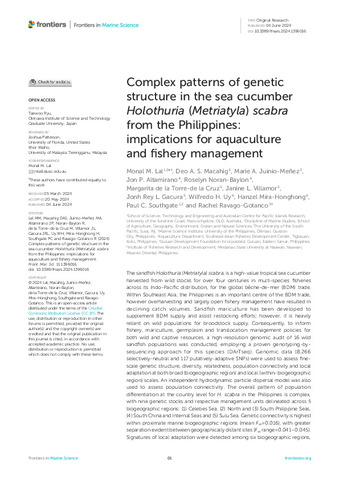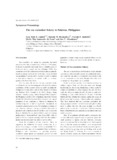Complex patterns of genetic structure in the sea cucumber Holothuria (Metriatyla) scabra from the Philippines: implications for aquaculture and fishery management

Associated URL
www.frontiersin.org日付
2024-06-04著者
Page views
166Metadata
アイテムの詳細レコードを表示するCited times in Scopus
Share
抄録
The sandfish Holothuria (Metriatyla) scabra, is a high-value tropical sea cucumber harvested from wild stocks for over four centuries in multi-species fisheries across its Indo-Pacific distribution, for the global bêche-de-mer (BDM) trade. Within Southeast Asia, the Philippines is an important centre of the BDM trade, however overharvesting and largely open fishery management have resulted in declining catch volumes. Sandfish mariculture has been developed to supplement BDM supply and assist restocking efforts; however, it is heavily reliant on wild populations for broodstock supply. Consequently, to inform fishery, mariculture, germplasm and translocation management policies for both wild and captive resources, a high-resolution genomic audit of 16 wild sandfish populations was conducted, employing a proven genotyping-by-sequencing approach for this species (DArTseq). Genomic data (8,266 selectively-neutral and 117 putatively-adaptive SNPs) were used to assess fine-scale genetic structure, diversity, relatedness, population connectivity and local adaptation at both broad (biogeographic region) and local (within-biogeographic region) scales. An independent hydrodynamic particle dispersal model was also used to assess population connectivity. The overall pattern of population differentiation at the country level for H. scabra in the Philippines is complex, with nine genetic stocks and respective management units delineated across 5 biogeographic regions: (1) Celebes Sea, (2) North and (3) South Philippine Seas, (4) South China and Internal Seas and (5) Sulu Sea. Genetic connectivity is highest within proximate marine biogeographic regions (mean Fst=0.016), with greater separation evident between geographically distant sites (Fst range=0.041–0.045). Signatures of local adaptation were detected among six biogeographic regions, with genetic bottlenecks at 5 sites, particularly within historically heavily-exploited locations in the western and central Philippines. Genetic structure is influenced by geographic distance, larval dispersal capacity, species-specific larval development and settlement attributes, variable ocean current-mediated gene flow, source and sink location geography and habitat heterogeneity across the archipelago. Data reported here will inform accurate and sustainable fishery regulation, conservation of genetic diversity, direct broodstock sourcing for mariculture and guide restocking interventions across the Philippines.
記述
The Supplementary Material for this article can be found online at: https://www.frontiersin.org/articles/10.3389/fmars.2024.1396016/full#supplementary-material
Keywords
sea cucumber SNP genetic structure fishery management dispersal Philippines conservation maricultureSuggested Citation
Lal, M., Macahig, D. A. S., Juinio-Meñez, M. A., Altamirano, J., Noran-Baylon, R. D., de la Torre-de la Cruz, M., Villamor, J. L., Gacura, J. R., Uy, W., Mira-Honghong, H., Southgate, P. C., & Ravago-Gotanco, R. J. (2024). Complex patterns of genetic structure in the sea cucumber Holothuria (Metriatyla) scabra from the Philippines: implications for aquaculture and fishery management. Frontiers in Marine Science , 11, 1396016. https://doi.org/10.3389/fmars.2024.1396016
主題
Taxonomic term
Collections
- AQD Journal Articles [1230]
Related items
Showing items related by title, author, creator and subject.
-
Approaches in Rebuilding Sea Urchin and Sea Cucumber Populations in the Philippines
Meñez, Marie Antonette J. (Training Department, Southeast Asian Fisheries Development Center, 2016)Sea urchins and sea cucumbers are among the most valuable and overexploited fishery resources. Culture and release of juvenile Tripneustes gratilla and Holothuria scabra have been undertaken to rebuild depleted populations ... -
Re-establishing the sea cucumber resources in the Philippines: The Masinloc experience
Alejandro, Marlon B. (Secretariat, Southeast Asian Fisheries Development Center, 2019)Sea cucumber of the Family Holothuriidae and Stichopodidae, is among the most commercially-exploited aquatic species in Southeast Asia in view of the increasing demand of their processed form in the international market. ... -
The sea cucumber fishery in Palawan, Philippines
Jontila, Jean Beth S.; Monteclaro, Harold M.; Quinitio, Gerald F.; Santander-de Leon, Sheila Mae; Altamirano, Jon(高知大学大学院黒潮圏海洋科学研究科, 2018)
This paper presents the nature of sea cucumber fishery in Palawan, Philippines with information on gathering practices, commonly traded species and secondary accounts on wild populations. Current issues on sea cucumber ...







